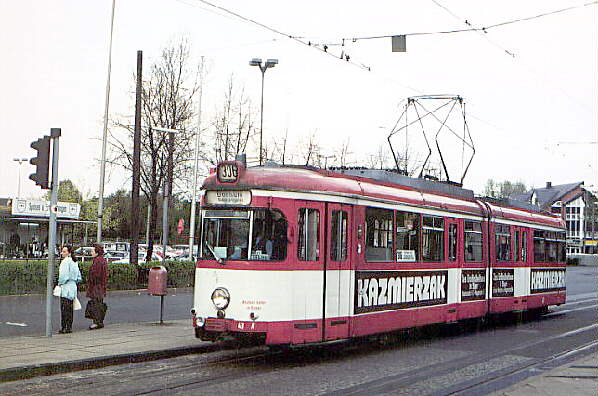
The 1960s saw plans to convert all the metre-gauge tramways to
standard-gauge Stadtbahn with high 90 cm platforms. Stadtbahn means
literally "cityrail" but is better translated as "segregated light
rail" - with all the costs this entails. The Stadtbahn plans resulting
in few improvements to the surface tramways. In the late 1980s, after
more than 20 years of construction, it was realised that the Stadtbahn
was too expensive for the benefits - many of which could be obtained by
improving, segregating and providing priority to surface alignments.
From the late 1980s government funding has concentrated on improving
and speeding up surface lines.
Many of them now get priority at traffic lights, and have
new 26cm high platforms providing level access to low-floor light rail
vehicles. These are already in service in Bochum-Gelsenkirchen,
Muelheim, Oberhausen and Duesseldorf; Essen and Duisburg are testing
new cars, so that only Krefeld and Dortmund remain without
low-floor-cars.
Level loading combined with faster,
reliable service is creating modern light rail systems in the Ruhr
without the full Stadtbahn costs and without the inconvenience of
tedious access to widely spaced underground stations.

Cars in the Ruhr:
Nearly all tramway, light rail and Stadtbahn-cars in
the Ruhr have been built by Duesseldorfer Waggonfabriken (Duewag), now
part of Siemens, which has a factory in Duesseldorf. Ruhr systems
followed the common practise of requiring cars to be locally built to
keep jobs in the region; particularly when funding was provided partly
by the regional government (Laender). EU rules now prohibit favouring
local manufacture but there seem to be ways of getting around this.
After the war the many two-axle trams were steadily replaced by
four-axle-cars and later six and eight-axle articulated cars, either
single- or double-ended. Many of these cars are still in service in
the Ruhr and other Germany systems as Koeln/Cologne, Mannheim and
Heidelberg. When retired many find a second
life on other systems in eastern Germany (from Duisburg to Dessau),
Turkey (from Koeln to Konya), Romania (from Bonn) and even
Japan (from Dortmund to Hiroshima). In the 1970s, the M6, M8 and N8 cars were developed
and purchased by Dortmund, Bochum-Gelsenkirchen, Essen, Muelheim and
Krefeld in the Ruhr, Bielefeld, Heidelberg and Freiburg elsewhere in
Germany. They all look similar with the main difference being gauge, (N
for standard or Normal, M for metre), and the number of axles (6 for
single articulation, 8 for double).
The Stadtbahn uses B80-cars where 80 stands for 80 km/h. Originally,
A-type cars were developed specifically for the Ruhr Stadtbahn but,
before a prototype was built, the B-type cars from Koeln were adopted.
Koeln and Bonn have the faster variant, the B100. The latest
development are low-floor-cars. Bochum- Gelsenkirchen started with the
MGT6D-cars (they have 42 cars now), Muelheim and Oberhausen have
followed. Outside the Ruhr, MGT6 or NGT6 cars are already running (or
have been ordered) in Brandenburg, Dresden, Duesseldorf, Erfurt,
Halle, Heidelberg, Kassel, Leipzig, Ludwigshafen, Mannheim and
Rostock; with very similar cars in service in Bonn. The cars carry a C
designation for chopper-control DC and D for Drehstrom (three-phase)
variable frequency and voltage AC propulsion. Other Ruhr systems are
expected to acquire low-floor-cars as their fleet becomes
life-expired. Most probably all non Stadtbahn cars will be low-floor
by 2020.
Tour:
A one day light rail tour of the Ruhr is possible. One
recommended route starts in Krefeld. Take a train to Krefeld Hbf
(Hauptbahnhof) and sample the Krefeld system. From Krefeld Hbf. take
interurban U70 or U76 (some trains have a dining-car) for Duesseldorf.
Get off at Belsenplatz and change to the U75 for Neuss. At Neuss
Stadthalle, change to tram 704 or 709 to Duesseldorf Hbf. You may of
course travel longer through Duesseldorf, but it is a big network!
Next take the other interurban U79, from the underground-station at
Hbf and go to Duisburg.
Again, some trains have a dining-car. At Duisburg Hbf,
change to tram 901 for Muelheim. At Muelheim Stadtmitte (terminus of
901), take some time to see a place where trams of four different
systems (Muelheim, Duisburg, Essen and Oberhausen) come together! Take
route 112 to Oberhausen (north of Landwehr, the route is completely
new) and back again to Muelheim Stadtmitte. From there, take either
the 104 directly to Essen or take the 102 to Muelheim Hbf and then the
U18 to Essen.
If you take 104, change
at Helenenstrasse and take 106 to Gelsenkirchen-Horst, change at
Ruettenscheider Stern and take the underground (lines U11, 101, 107,
127) to see the mixed gauge section. In either case you reach to Essen
Hbf where you board route 106 for Gelsenkirchen-Horst and transfer to
Bogestra-line 301 all the way to Gelsenkirchen Hbf. (It is also
possible to take faster route 127 directly from Essen to Gelsenkirchen
Hbf.)
At Gelsenkirchen Hbf, change to route 302 and to go Bochum Hbf. At
Bochum Hbf, there may be time to travel on other Bogestra lines before
taking the 310 to Witten-Heven. From Witten Hbf take the S-Bahn S5
(DBAG-train) for Dortmund (every 30 minutes). This is necessary as
there is no longer a tram connection between the Bogestra and the
Dortmund networks. Get off at Dortmund-Barop and walk over to the stop
for line 408, called "Harkortstrasse". This is located about 400 m
from the station: first walk southwards, and then follow the street
Harkortstrasse eastwards until you see the tram. Take 408 to the
city-centre. You can then sample the isolated Dortmund network before
returning to your origin from Dortmund Hbf by train.
If you have even more time, visit the Schwebebahn (monorail) in
Wuppertal and the trolleybus-network in Solingen. For planning your
tour note that light rail lines run every 10 or 20 minutes, more
frequently in the rush-hour, with reduced service in evenings, on
weekends and during school holidays (every 15, 20 or 30 minutes).
There are no dining-cars in the evening and on weekends (except on
the U76 on Saturday mornings).